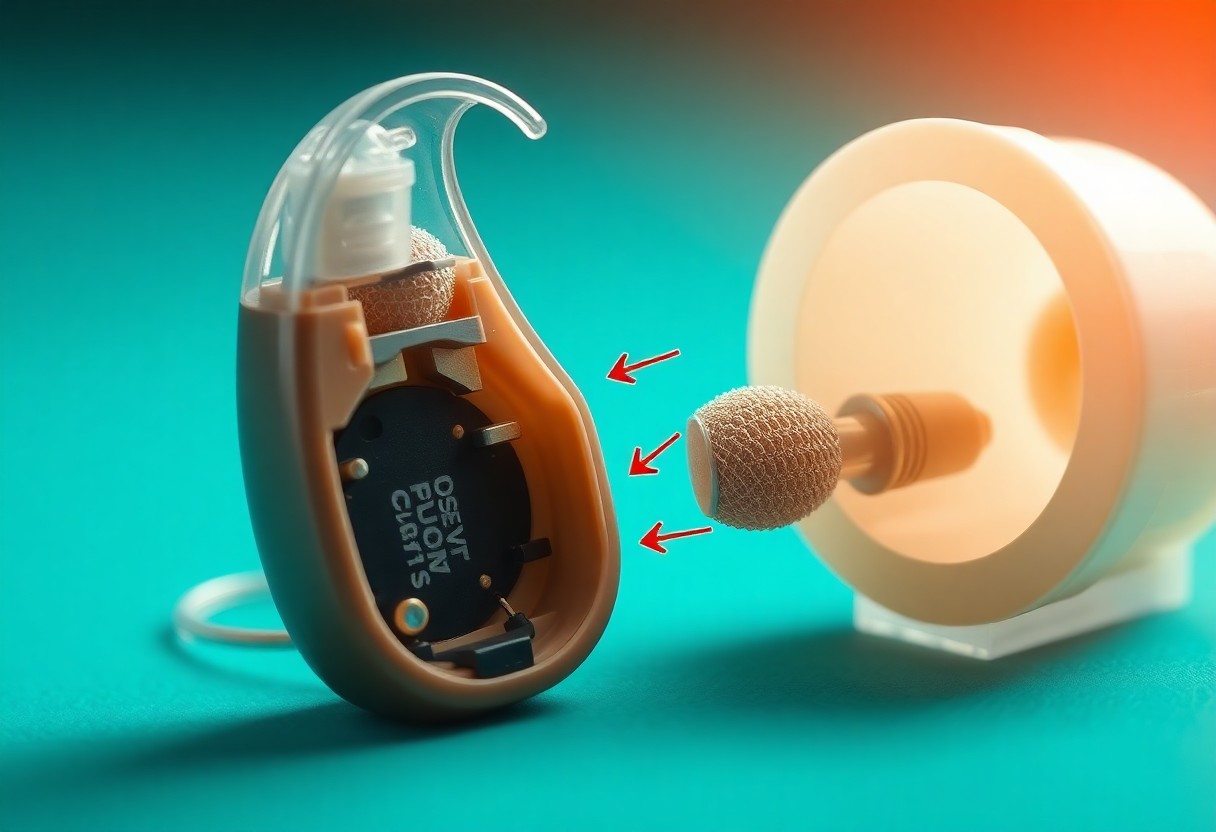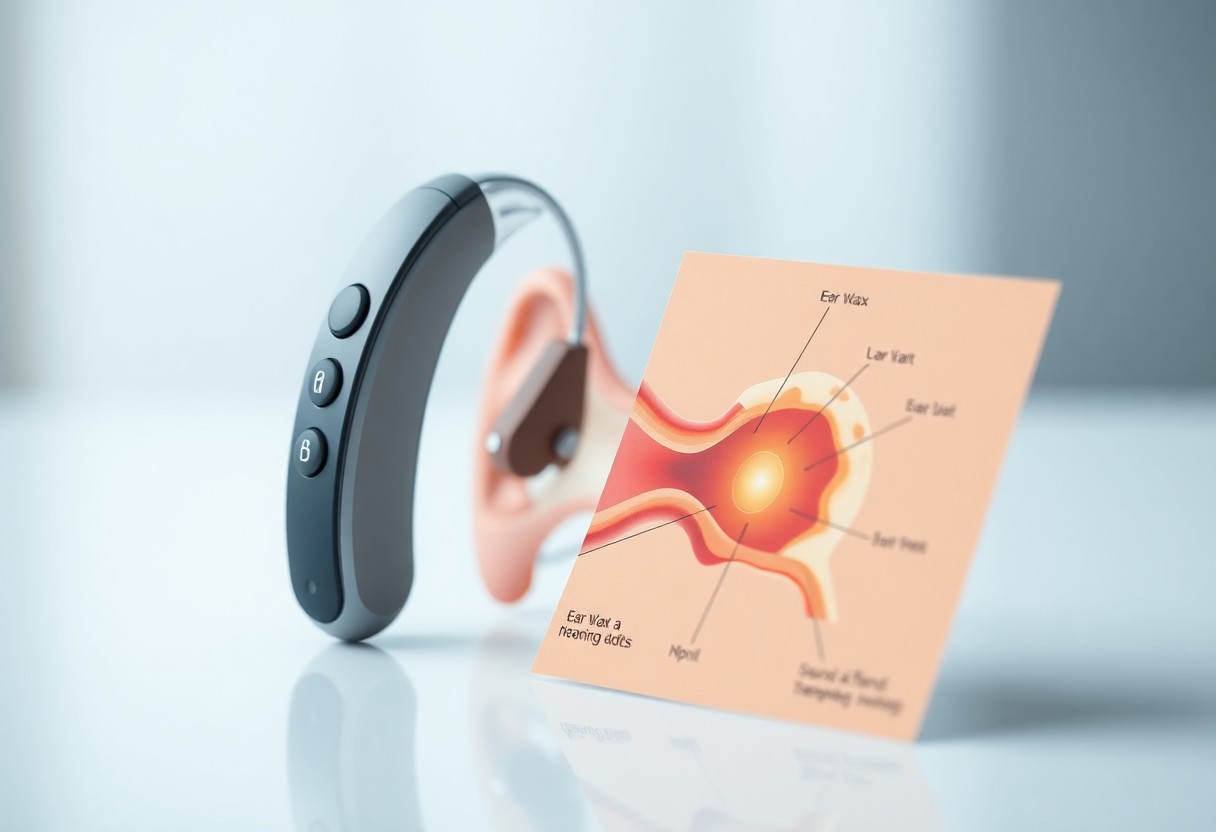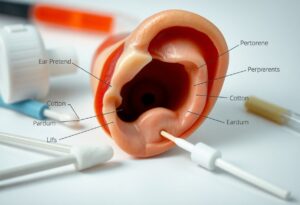Most people are unaware that impacted ear wax can significantly affect the performance of your hearing aids. As ear wax builds up in your ear canal, it can obstruct sound transmission, leading to auditory distortion and an overall decrease in hearing aid effectiveness. Understanding the relationship between ear wax and hearing aids is important for maintaining optimal hearing health and device functionality. This post will explore how impacted ear wax interferes with sound quality, enabling you to take proactive steps for clearer hearing.
Key Takeaways:
- Impacted ear wax can obstruct sound pathways, leading to reduced clarity and volume in hearing aids.
- The presence of ear wax can cause feedback issues in hearing aids, resulting in auditory distortion.
- Regular cleaning and maintenance of both ears and hearing aids are vital for optimal performance.

The Anatomy of Hearing Aids: How External Factors Influence Performance
Understanding the internal structure of hearing aids helps you appreciate how external factors impact their functionality. Various elements within hearing aids are designed to capture, amplify, and process sound efficiently. Here are some external factors that can influence their performance:
- Environmental noise levels
- Humidity and moisture exposure
- Battery lifespan and performance
- Head position and movements
- Ear wax buildup
Key Components of Hearing Aids
Hearing aids consist of several critical components including a microphone, amplifier, receiver, and battery. The microphone captures sound waves from the environment, converting them into electrical signals. The amplifier boosts these signals before sending them to the receiver, which translates them back into audible sound. The battery powers these functions and determines overall device longevity.
The Role of Sound Processing in Auditory Clarity
Sound processing is vital for enhancing the clarity of sounds you perceive through hearing aids. Advanced digital signal processors analyze incoming sounds, filtering out background noise while highlighting speech frequencies. This technology adjusts the gain based on your listening environment, ensuring you hear effectively both in quiet settings and noisy situations.
Specific algorithms enable hearing aids to tailor sound delivery to various listening scenarios. For instance, directional microphones focus on sounds coming from in front of you, improving understanding in crowded spaces. Noise reduction features minimize distractions, allowing for clearer conversations. As a result, your experience is significantly enhanced, making everyday interactions more enjoyable. Any fluctuations in sound processing efficiency caused by impacted ear wax can diminish these benefits, resulting in auditory distortion and reduced clarity.
The Science of Ear Wax: Understanding Its Natural Function
What is Ear Wax and Why Is It Important?
Ear wax, or cerumen, is a naturally occurring substance produced by glands in the ear canal. Its primary role is to protect your ears by trapping dust, debris, and microorganisms, thus preventing infections. Additionally, ear wax maintains the moisture of the ear canal skin, preventing it from becoming dry and itchy. Without this protective layer, your auditory system would be more susceptible to environmental threats.
The Fateful Transitions: From Protective Substance to Problematic Blockage
Over time, if ear wax buildup exceeds natural self-cleaning mechanisms, it can harden and create a blockage. This transition transforms a protective substance into an obstacle for sound transmission, leading to auditory distortion, especially for hearing aid users. Factors such as the shape of your ear canal, excessive ear wax production, and poor ear hygiene can contribute to this issue.
This transformation from ear wax as a protective barrier to a problematic blockage highlights the delicate balance your body maintains. Typically, ear wax naturally migrates out of the ear canal, but when it accumulates or becomes impacted, it can obstruct your hearing aids, diminishing sound quality and clarity. In some cases, individuals may even experience muffled hearing or a dullness that significantly impacts daily communication. Regular check-ups and maintenance are vital to prevent ear wax from causing these auditory disruptions, ensuring your hearing aids function effectively.
Impacted Ear Wax: Symptoms and Diagnosis
Identifying the Signs of Impacted Ear Wax
Impacted ear wax often manifests through a variety of symptoms. You may experience muffled hearing, a feeling of fullness in the ear, ringing or buzzing sounds (tinnitus), or even discomfort. In severe cases, you could notice dizziness or balance issues. Recognizing these signs early can aid in timely intervention and prevent further auditory complications.
Diagnostic Procedures for Evaluating Ear Health
Your hearing health professional may employ several diagnostic techniques to evaluate the state of your ears. A visual inspection with an otoscope allows the expert to assess for blockages, infections, or abnormal ear canal conditions. Audiometric testing may also be performed to measure your hearing threshold and determine any loss.
In addition to visual inspections and audiometric tests, detailed patient history assessments can provide insight into your ear health. Professionals often inquire about your symptoms, medical history, and any previous ear treatments you’ve had. This comprehensive approach ensures that any underlying issues are thoroughly understood before deciding on a treatment plan for impacted ear wax.
Auditory Distortion: A Deep Dive into the Acoustic Challenges
How Impacted Ear Wax Interferes with Sound Quality
Impacted ear wax obstructs the ear canal, hindering sound waves from reaching your eardrum effectively. This buildup creates a barrier that alters the frequency response of sounds, making them appear muffled or distorted. As your hearing aids attempt to amplify sound, they may struggle against this blockage, resulting in diminished overall sound quality. The sharpness of high frequencies, vital for understanding speech, becomes particularly compromised as the wax dampens important auditory signals.
The Specific Auditory Distortions Caused by Wax Blockage
Auditory distortions from wax blockage present in various forms, often manifesting as muffling, echoing, or garbled speech. Sounds may also become flat or tinny, disrupting your ability to discern different tones. This degradation significantly affects speech comprehension, especially in noisy environments where clarity is vital for effective communication.
Specific auditory distortions often encountered due to wax blockage can include notable changes in clarity and volume. For instance, high-pitched sounds like consonants may seem faint or entirely absent, while booming low frequencies may dominate, creating a disorienting effect. Speech recognition drops considerably; studies indicate that individuals with hearing aids in the presence of wax blockage report a 30% reduction in clarity. Consequently, navigating conversations or enjoying music can become frustrating and exhausting, as your hearing aids struggle to compensate for the compromised acoustic environment.
Intervention Strategies: Addressing Ear Wax Buildup Effectively
Professional Cleaning Techniques: What to Expect
Seeking professional cleaning typically means visiting an audiologist or an ear, nose, and throat (ENT) specialist. They may use methods like suction or curettage, which safely remove ear wax without risking damage to your ear canal or eardrum. You can expect a thorough examination of your ears prior to the procedure, and it often takes only a few minutes. Most professionals recommend this approach for severe buildups to ensure complete removal and to prevent recurrence.
At-Home Remedies: Pros and Cons
At-home remedies for ear wax buildup can be tempting, but they come with advantages and drawbacks. Common methods include using ear drops, mineral oils, or warm water irrigation. While some may be effective in softening wax, improper use might lead to complications like ear infections. Evaluating these remedies carefully is crucial for maintaining ear health.
Pros and Cons
| Pros | Cons |
|---|---|
| Convenient and easily accessible | Risk of causing ear infections |
| Cost-effective solutions | May not effectively remove hard wax |
| Can soften wax for easier removal | Poor technique can worsen the blockage |
| No appointment necessary | Risk of damage to ear canal |
| Various options available | Limited guidance on safe usage |
You should weigh the effectiveness of various at-home remedies against the potential risks. Options like hydrogen peroxide or saline solutions can soften ear wax, but using them without professional advice may lead to irritation or incorrect application. Understanding your specific ear conditions can tailor the approach to best suit your needs, ensuring that you maintain good ear health.
The Importance of Regular Hearing Assessments
The Role of Audiologists in Preventative Care
Audiologists play a vital role in preventative care, offering specialized knowledge that helps identify hearing issues before they become more serious. They assess your hearing abilities and provide tailored advice on managing ear health, including the prevention of ear wax buildup. Regular consultations with an audiologist ensure that any potential auditory challenges are detected early, allowing for prompt intervention and optimal hearing support.
Recommendations for Frequency of Hearing Evaluations
Routine hearing evaluations are recommended every one to two years for adults, especially if you are over 50 or have risk factors such as a family history of hearing loss. Those experiencing changes in hearing or using hearing aids should consider assessments more frequently, potentially every six months. Individual health status and lifestyle can also influence the frequency of these evaluations.
Specific health conditions like diabetes, obesity, or cardiovascular issues may necessitate more frequent assessments, as they can contribute to hearing loss. Those who are frequently exposed to loud environments should also prioritize yearly check-ups, as early detection can lead to interventions that preserve hearing. Tailoring the frequency based on your unique circumstances empowers you to stay proactive in your auditory health journey.
Real-Life Implications: The Broader Impact of Auditory Distortion
Psychological Effects of Hearing Challenges on Daily Life
Experiencing auditory distortion can significantly affect your overall quality of life. You might find yourself feeling isolated from conversations, which can lead to frustration and anxiety. Social situations may become daunting, as the inability to hear clearly can cause misunderstandings and embarrassment. This growing discomfort can lead to withdrawal from social interactions and a reduction in your overall life satisfaction.
The Connection Between Auditory Health and Overall Well-Being
Good auditory health is intrinsically linked to your overall well-being. Studies show that untreated hearing challenges, including auditory distortion, can contribute to cognitive decline and increase the risk of depression. By maintaining your hearing health, you actively support your mental faculties and emotional health, boosting confidence and engagement in daily activities.
Prioritizing auditory health can enhance your social connections and daily interactions. For instance, research indicates that individuals who address hearing loss early are less likely to experience feelings of loneliness and isolation. This is especially vital as you age; staying socially engaged is associated with lower rates of cognitive decline. Investing in your hearing not only improves clarity but fosters a sense of belonging and purpose, ultimately enriching your life experience.

Emerging Technologies: Innovations in Hearing Aid Design
How Advanced Hearing Aids Manage Wax-Related Issues
Advanced hearing aids are now equipped with sophisticated technologies that directly address wax-related challenges. These devices often include self-cleaning mechanisms, moisture-resistant designs, and wax guards to prevent buildup. With real-time monitoring and feedback features, they adjust settings automatically to enhance sound quality when wax is detected.
Features of Advanced Hearing Aids
Future Directions: What’s on the Horizon for Hearing Aid Technology
The future of hearing aid technology promises significant advancements, including AI integration for personalized audio experiences. Innovations such as extended battery life through wireless charging, augmented reality capabilities for enhanced environmental awareness, and advanced connectivity with smart devices are expected. These developments aim to improve your overall auditory experience, making hearing aids more user-friendly and effective in daily life.
AI-driven hearing aids will learn from your environment, optimizing sound quality based on real-time data. Wireless charging technology aims to eliminate the hassle of battery replacements, while augmented reality features may provide richer soundscapes, enhancing your experience in complex listening environments. As these technologies emerge, they promise to create a seamless integration of hearing solutions into your lifestyle.
Summing up
Taking this into account, impacted ear wax can significantly affect the performance of your hearing aids by obstructing sound pathways and distorting audio quality. This blockage can lead to muffled sounds and reduced clarity, making it necessary for you to regularly check and maintain your ear hygiene. By addressing ear wax buildup and ensuring your hearing aids are clean, you can enhance your listening experience and enjoy better auditory performance.
FAQ
Q: Why does impacted ear wax affect hearing aid performance?
A: Impacted ear wax can block the microphone and speaker of hearing aids, leading to reduced sound quality and distortion. This blockage prevents clear sound transmission and alters the audio input the hearing aid receives.
Q: How does ear wax buildup lead to feedback in hearing aids?
A: When ear wax accumulates, it can interfere with the hearing aid’s fit in the ear canal, creating gaps. These gaps can cause sound to leak out and then re-enter the microphone, resulting in feedback or whistling sounds.
Q: What symptoms indicate that ear wax is impacting hearing aids?
A: Common symptoms include muffled sounds, distortion, unusually loud feedback, and the hearing aid cutting in and out. Users may also experience a change in their ability to hear certain frequencies clearly.
Q: How can one address ear wax-related issues with hearing aids?
A: It is recommended to regularly clean the ears and consult a healthcare professional for ear wax removal. Additionally, ensuring the hearing aids are appropriately fitted can help minimize the effects of ear wax.
Q: Can frequent cleaning of hearing aids prevent issues caused by ear wax?
A: Yes, regular cleaning of the hearing aids can help reduce the buildup of ear wax on the devices. Using a soft cloth and following manufacturer guidelines for maintenance can improve performance and longevity.



